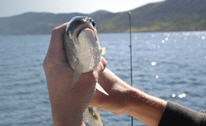|
Trout Fishing BasicsIf you are planning on spending some time away on a trout fishing trip or vacation, this guide shares tips and ideas to help you get the most out of your next trip away. Trout fishing is an activity that hundreds of thousands of people enjoy every year...let's find out why... Imagine standing on the bank of a clear, cool stream casting into a pool just outside of the swiftly moving current.
You quickly set the hook and the fight is on. You can see the fish flip and thrash in the water, trying to escape the bite of the hook that's embedded in its mouth. It's a good sized fish. As you land it you realize you've caught a beautiful trout. There are several species of trout, including brown, brook, rainbow, cutthroat and steelhead. There are also some species of sea trout. These species feed on insects, insect larvae, crustaceans and smaller fish. Trout are native to Asia, Europe and North America. During the 19th century, they were introduced to Australia and New Zealand by enthusiastic anglers. Where To Fish For TroutTrout fishing is best in easily recognizable narrow areas in cool lakes, rivers and streams where fast, rapidly moving water meets slow, and where deep water meets shallow. They can also be found where rocks and rock shelves offer tranquil relief from the current. Rainbow trout feed in faster water that runs approximately six feet per second. Other species of trout feed in slower waters where water runs approximately one foot per second. They also like to hang around large objects that slow the current, such as rocks or rock shelves. Trout like to rest where fast water meets slow and adjacent to the main current. Find the main current by watching bubbles and debris that moves through the pool or run. Look to the head of the pool and find where the faster water spills into it. Trace its path through the pool to find the places where trout lurk, waiting for prey. When a tree falls into the water at a right angle to the current and the trunk is still rooted in the bank, anglers call it a sweeper. The best places for trout fishing here are just outside of the branches, in front of the crotch where the sweeper meets the bank. What Is The Best Bait And Tackle For Trout Fishing?There are a wide variety of both live and artificial baits that will get you a good sized trout. Cured salmon eggs, earthworms, marshmallows, insects, insect larvae, kernel corn, egg sacs, crayfish, artificial and live minnows, spinners, spoons, Mepps and wet and dry flies are all great when fishing for trout. If you are fly fishing for trout, you will need a 9 foot graphite or fiberglass fly rod to allow you to cover the widest range. Add 75 feet of line to your reel if you plan to catch trout that is over 4 pounds. You will also need thigh or chest waders, a fisherman's vest with lots of pockets for flies, a knife and a fishing basket for your catch. Both wet and dry flies can be used to fish for trout. Experienced anglers can give you tips that will make your trout fishing experience a positive one. We hope this guide to trout fishing has given you the basics you need to tackle your next fishing adventure...To read more about fishing, click here to return to the Fishing Home Page
|





 Before you realize it, you have a strike.
Before you realize it, you have a strike.